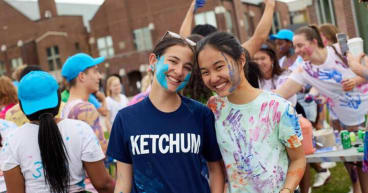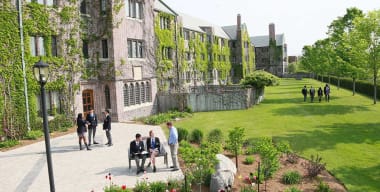According to research, school-based physical education programming can be very effective in promoting youth activity levels and health status (Stone et al., 1998; Ernst & Pangrazi, 1999). Even so, many students in Ontario feel there is no room in their timetable to take an elective course like Health and Physical Education now that high school lasts only four years. What can be done to help children become more active and keep these alarming statistics in check?
At Trinity College School (TCS), in Port Hope, Ontario, enrolment in Health and Physical Education (HPE) was declining after Grade 9. The school offers a comprehensive co-curricular program to help keep students active, but something needed to change to keep students enrolled in HPE. Given that TCS campus is uniquely situated to take full advantage of a variety of outdoor education sites--from the Ganaraska Forest and the Kawartha Highland Provincial Park to the immediate proximity of Lake Ontario and the Ganaraska River--we turned to our Outdoor Education focus courses.
Initially, TCS offered only one Grade 11 class of Outdoor Education. Four years ago, the school developed a Grade 10 course and an additional Grade 11 Health and Physical Education Outdoor Education focus class that is offered outside the normal timetable. Enrolment in outdoor education courses has quadrupled.
Survey results indicate that TCS students thrive on the opportunities presented in Outdoor Education to pursue activities that are more lifestyle-oriented, rather than the traditional games of basketball and volleyball. Now, students first get an introduction to many new skills and activities at Grade 10 and build upon them in Grade 11. These Grade 11 students are challenged in new and more demanding ways than the Grade 10 classes.
Students appreciate the chance to progressively develop new skills. For example, Grade 10 students initially learn different mountain biking strategies and basic bike repair techniques as well as completing moderate cycling routes around Port Hope. In Grade 11, students are taken on more advanced forest trails. Grade 10 students go camping at Pres Qu'ile Provincial Park, while the Grade 11s go on a self-sufficient canoe/camping trip complete with portages.
Essentially, Grade 10 students are exposed to a variety of activities that can be pursued well past high school, and the Grade 11 course expects them to tackle these activities more independently and in different environments.
As a teacher, it is refreshing to see students clearly invigorated by the natural scenery and taking great pride in testing their skills in challenging outdoor settings. It is remarkable to see students who once begrudged participating in fitness activities now become self-motivated to be in motion.
One good example of this is when the class goes canoeing. Students are expected to jog or speed walk to the Ganaraska River two kilometres from the school. In this course, students run as a mode of transportation rather than simply completing laps in a gym for a set amount of time. Canoeing class includes students willingly sprinting the distance (at least part of it) to the river because they want to get on the water faster with one of the better canoes.
Given the weight of some of the canoes over our short portage route down to the river, students also quickly realize the need to improve their strength. They can see the immediate benefits of improving their level of fitness; it becomes a real life-priority. And the teachers aren't exempt; professional development now includes getting fit so as not to be left behind!
The Grade 11 course is taught during lunchtime, after school or in the evening. Students must apply to participate and must be able to manage the independent study requirements of the course. They are typically academically strong students who are passionate about the outdoors and want to stay active throughout the year.
Students meet all the ministry requirements, but have greater flexibility in determining when they are learning, based on their other commitments. Early in the year, the class discusses and negotiates when will be the best time to meet. If sports and other course work is particularly challenging, we might not have a class. During "non-peak" times, we might meet several times in a week. As a result, the students in this course learn time management skills that will be useful later on when they want to balance careers with a healthy, active lifestyle.
Although all the ministry expectations are met, the course varies from year to year, depending on the prior knowledge and skill base of the students. Even the culminating trips vary, subject to the interests of the class. For example, the first year the course was offered, students travelled to Banff and Canmore but most recently, the group has enjoyed the Temagami wilderness, and has gone winter camping and learned first-hand about aboriginal culture and environmental issues confronting Northern Ontario.
The course content is well received because students quickly realize how frequently the skills and knowledge they are learning will be applied throughout these trips. For instance, every class member works toward being able to sustain 40 minutes of moderately vigorous activity so everyone will be able to participate fully in such group activities as snowshoeing, dogsledding or cross-country skiing. In Outdoor Education class, homework is a workout for both the body and the brain.
To learn leadership, students must be given frequent opportunities to practise their skills. During both the trips and other after-school activities, students are expected to lead and teach their peers, based on the areas of expertise they have developed over the year. One student became an expert in building quinzies (snow caves dug out of giant piles of snow). While we were in Temagami, he supervised the construction of three quinzies in which the group slept. It is not unusual for the temperature to plummet to -30°C overnight, so the care taken in overseeing the building of the snow caves directly relates to the comfort (and survival) of the class.
In Outdoor Education, students learn to live and work together, to tolerate individual differences, and to feel a sense of responsibility and commitment toward other students as well as to the task at hand. Ultimately, learning by doing ensures greater understanding; having fun along the way pushes productivity, creativity and achievement to a peak. As students are engaged and challenged, the learning makes an impact that will last forever.
As early as 350 BC, Aristotle issued a declaration to educators that remains central to good practice: "The results of good physical education are not limited to the body alone, but they extend to the soul itself." In our more sedentary and technologically driven age, if we are to continue to respond to Aristotle's challenge, then the benefits of outdoor education are obvious.








